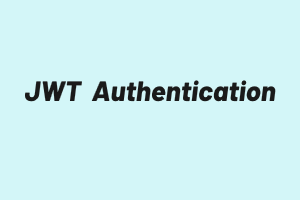Introduction:
In the realm of web application security, authentication plays a pivotal role in ensuring that only authorized users can access protected resources. JSON Web Tokens (JWTs) have emerged as a popular and robust method for implementing authentication in modern web applications. This post will delve into the technical aspects of JWT authentication, explaining how it works, its benefits, and best practices for implementation.
What is JWT Authentication?
JSON Web Tokens (JWTs) are compact, URL-safe tokens that securely transmit information between parties as JSON object. JWTs consist of three parts: a header, a payload, and a signature, separated by dots. The header contains information about the token’s type and signing algorithm, while the payload carries the claims or statements about the user. The signature is used to verify the integrity of the token.
The JWT Authentication Process:
- User Authentication: When a user provides their credentials (e.g., username and password) to the authentication server, it verifies the credentials and generates a JWT if they are valid.
- Token Issuance: The authentication server creates a JWT, populates it with relevant user information (claims), and signs it using a secret key.
- Token Transmission: The JWT is returned to the client and typically stored in client-side storage, such as local storage or cookies.
- Request Authorization: For subsequent requests to protected resources, the client includes the JWT in the Authorization header of the HTTP request.
- Token Verification: The server receiving the request extracts the JWT from the Authorization header, verifies the signature using the shared secret key, and decodes the token to access the user’s claims.
- Access Control: Based on the information in the JWT, the server performs necessary checks, such as verifying the user’s identity and permissions, to grant or deny access to the requested resource.
Benefits of JWT Authentication:
- Stateless: JWTs are self-contained and do not require the server to store the session state. This allows for easy scalability and reduces server-side storage requirements.
- Decentralized: JWTs enable authorization to be performed by the resource server itself, without relying on a centralized authentication server.
- Flexibility: JWTs can carry custom claims, allowing for the transmission of additional user-specific information.
- Security: By signing the token, JWTs ensure data integrity, preventing tampering and unauthorized modifications.
- Cross-Domain Compatibility: JWTs can be used across different domains and platforms, enabling the implementation of single sign-on (SSO) and federated authentication.
Best Practices for JWT Authentication:
- Secure Key Management: Safeguard the secret key used to sign the tokens. Store it securely and restrict access to authorized personnel.
- Token Expiration: Set an appropriate expiration time (e.g., short-lived tokens) to mitigate the risk of token misuse. Implement token refreshing mechanisms as necessary.
- Transport Security: Transmit JWTs over secure channels (HTTPS) to prevent interception and eavesdropping.
- Token Revocation: Establish a mechanism to revoke compromised or invalidated tokens (e.g., using a token blacklist or revocation list).
- Claims Validation: Validate the claims within the JWT to ensure the integrity of the information and prevent unauthorized access.
User Permissions and Access Control: Implement appropriate access controls on the server side based on the user’s claims and roles.
Conclusion:
JWT authentication offers a powerful and flexible approach to securing web applications. By utilizing self-contained tokens, JWTs provide stateless authentication, enabling scalability and promoting decentralized authorization. Following best practices in key management, token expiration, transport security, and claims validation ensures the robustness and integrity of the authentication mechanism. Incorporating JWT authentication into your web application enhances its security.
Get certification for your knowledge in the fundamentals of Computer functioning by clearing the Computer Certification exam conducted by StudySection. After going through this Computer Certification Exam, you will be able to evaluate your basic knowledge of computers.




